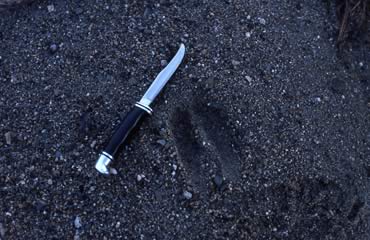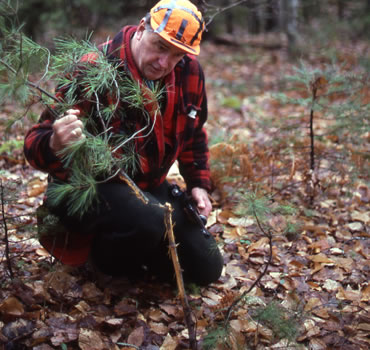By Joel S. Fawcett
The time to start planning for next year’s big buck is immediately after this season.
Deer season is over, and you struck out.
If that describes your experience, perhaps you should incorporate a scouting regimen into the off-season. I began to pattern bucks back when I was a registered guide, and my success in predicting hot locations for my clients convinced me to continue to pattern deer after I retired.
Although my forte is still-hunting with an occasional ground blind mixed in, I’ve used off-season scouting as an aid to put one, sometimes two, husky whitetails on the game pole for 32 straight seasons while hunting the big woods of Maine, Nova Scotia and New Brunswick.
The prime time to look for next year’s buck is immediately after this year’s deer season ends. That’s when deer sign is still visible and is easy to read and interpret. You can pinpoint the herd’s preferred feeding grounds, water holes, cover/bedding areas, doe and fawn thoroughfares, mature buck trails and funnels, major scrapes and rub lines.
Most of the information you pick up during this year’s scouting will be useful during next year’s hunting season, and likely for future seasons as well. Unless there’s a drastic change in the landscape due to logging, farming, weather disaster or human invasion, the deer in your area will pretty much do next year what they did this year. And you can scout places after the season that you’d dare not disturb while hunting. Although a wily old buck might have a long memory, he’ll forget you met long before opening day of next year’s season.
The first step in a post-season scouting plan is to decide on the boundaries of your hunting area. Have you hunted it previously or is the property completely new to you? And how much time will you devote to scouting?
When it comes to whitetail woods, think small. I’d rather know a small tract intimately than a large area skimpily. I typically pick streams or river banks, woods roads, ridges and clear-cuts as boundaries. Or I might arbitrarily pick a border by how far I want to hunt or the distance I feel like dragging a carcass. For example, I like to hunt near water, and I rarely hunt much more than a half mile from a stream, river, lake, pond or flowage shore. My experience indicates that you’ll find many more big whitetails within half a mile of water than you will in the next five or six miles combined.
A good way to know the overall terrain of the hunting area is to obtain topo maps and aerial photos. If you can’t buy them locally, a good source is maptech.com. These maps show a wealth of information. The aerial photos are more expensive, but they make it easy to pick out potential bedding/cover areas, feeding grounds, obvious trails and funnels. However, topo maps and a compass are the most useful scouting tools.
Once you’ve spent some time studying topos and aerial photos and have identified likely deer habitat, it’s time to head to the woods. Start by walking the boundaries and any natural or man-made roads, fence lines, ridges or valleys. Keep a sharp eye out for heavy trails and other deer sign.
 Once I get the big picture of the area, I look for travel routes and funnels the big bucks use. Mature bucks are lazy critters. To get from point A to point B, they’ll almost always take the easiest, quickest route available.
Once I get the big picture of the area, I look for travel routes and funnels the big bucks use. Mature bucks are lazy critters. To get from point A to point B, they’ll almost always take the easiest, quickest route available.
When scouting a buck trail, keep an eye peeled for funnels. My favorite funnel is a shallow river crossing bordered both upriver and downstream by a long stretch of deep or fast water. Whitetails are good swimmers. When camping and/or fishing in the summer and early fall, I often observe deer swimming across a lake or river. In late May or early June, pregnant does sometimes swim to an island to drop their fawns away from dangerous predators. Also in the early fall, deer will frequently swim out to an island or across a lake or river to forage on a good crop of beechnuts, acorns, hazelnuts, apples or cranberries. But once the weather turns cold, the deer avoid taking a swim.
When I find a funnel, I look around to see if there are any other trails intersecting the bottleneck. If so, I backtrack to find where those trails come from. Look for big tracks and table-size scrapes.
However, the sign that intrigues me more than any other are trails marked by a big rub or, better yet, a line of rubs on some stout, thigh-thick trees.
All buck sign is important, however, and I mark each discovery and its position on my topo map. Even if a bragging-size buck was harvested from a property, another big buck is almost sure to move in and claim the area before the next deer season, often within a week of the original buck’s removal.
Once winter arrives in earnest, bringing frigid temperatures, deep snow and wind, the deer head for the lowlands and heavy cover. My winter scouting is mostly devoted to taking a census of the deer-yard population in my selected area. How many big bucks are there? Is the big buck that evaded me last fall still around? Even if you don’t actually see a monster, you can tell a lot about the animal from the size of its bed, tracks and droppings, and how deep its hooves sink into the snow.
 Now and then I stumble upon a shed. If you find a shed near a deer yard, don’t attach any extra meaning to it, other than that a buck made it through the hunting season. The trails, food sources and cover/bedding areas the deer use in the fall almost always differ from those they use in the brunt of winter.
Now and then I stumble upon a shed. If you find a shed near a deer yard, don’t attach any extra meaning to it, other than that a buck made it through the hunting season. The trails, food sources and cover/bedding areas the deer use in the fall almost always differ from those they use in the brunt of winter.
If you live or hunt in an area with harsh winters, avoid bumping deer from their winter sanctuaries. Any energy a deer uses to evade you is that much less it will have to draw on to make it through to spring. Bucks, especially, have little reserve, having used much of their stored fat while chasing does during the rut.
Instead of focusing on deer in the winter, look for trees that produce mast crops that ripen and drop in the fall. These include beechnut, oak, hazelnut, apple, crabapple, thornapple and serviceberry. Whenever you’re able to check out the mast trees, be sure to mark the better areas on your scouting map.
Using my marked-up topo maps, May and June are when I select my ground blind locations and still-hunting routes. Treestand hunters should select their sites then, too.
In May, June and early July, with the landowner’s permission, I construct ground blinds, erect treestands and establish access routes to and from stands. And it’s not too early to think about shooting lanes.
Since it’s always good to learn something about the deer you’re hunting, it’s difficult to say that scouting in the summer and early fall is bad. But if you’ve scouted when you should have, you don’t need to risk putting your buck on edge. Instead, since I know you can’t do nothing, use good binoculars to glass fields and woods edges from afar, or practice shooting your gun or bow. Although you won’t see every buck in the area while glassing, you’ll get a look at a few of your potential tag candidates, which will help you decide whether or not to shoot when one walks under your stand.
In order to take big bucks consistently, you have to change the way you think about deer hunting — and how you scout. Hunters who say they don’t have time to scout and get ready for deer season aren’t scouting at the right time. If you start to plan and scout for next year’s buck right after deer season, you’ll have plenty of time to do all the other things to be ready — like adding on a trophy room to hold all those buck mounts.
Read Recent Articles: • Ready, Set, Reload! One of the most important skills of blackpowder hunting is the ability to reload quickly.
• Deer Pelletology: Can hunters learn anything useful from deer droppings?
• Making It Count: Missouri teenager makes the most of his last season as a youth hunter.
This article was published in the Winter 2008 edition of Buckmasters Whitetail Magazine. Join today to have Buckmasters delivered to your home.